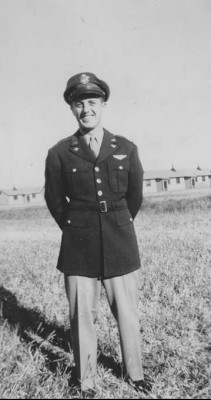27 Feb The B-17 Bombardier
Herman received Bombardier training at Victorville as well as navigator training at Carlsbad. He had been taught to use the Norden bombsight, that highly guarded military secret. The training manuals were very complex, full of math and physics. Remember, these airmen didn’t have the technical resources we would count on today. They used hard copy maps, given to them in that morning’s briefing.
The bombardier flew right up front in the plexiglass nose of the B-17. He had a panoramic view of everything out there … good and bad. In my post with the B-17 photographs, William S. “Bill” Dixon added some excellent information about the bombardier:
The view from the bombardier’s position was probably the scariest of all. He could see all of the flak ahead of us and from 9 o’clock to 3 o’clock plus he got a head-on view of all the winking lights from those little planes that were attacking from the front. (For the uninitiated, those winking lights were 20-mm cannon fire.) In addition to manning the bombsight (or dropping when the lead plane did,) the bombardier manned the nose turret and the device in the upper right of the picture is the control for that turret.
During the bomb run, the bombardier, through the bombsight, controlled the plane and his full attention was devoted to the task of dropping the bombs exactly where they were supposed to go. A difficult task when you know you are being attacked but necessary because that was the whole purpose of the mission.
Since the Bombardier’s responsibility was making sure that the bombs or the “payload” fell accurately on the target, the success or failure of the mission was largely on his shoulders. As Bill described above, once it was determined that the bomb was ready to be released, the bombardier took over total control of the airplane until “Bombs away.”
Herman was 27 years old, approximately the same age as his pilot and co-pilot and older than most of the rest of the crew members he flew with. I am struggling this morning, trying to imagine the different emotions he might have experienced during these bombing runs. Fear, excitement, panic, regret, pride, determination.
My friend, Monroe F. “Buddy” Stamps, told me that the officers (pilots, navigator, bombardier) were role models and would not want to show fear in front of the other crew members. And he said that “bravery” was not letting down your crew.
I want to read the book Shot at and Missed by Jack R. Myers, a B-17 bombardier during World War II. I am looking for additional insights into the experiences of the bombardier. Since Herman doesn’t remember being there, my clues come from Herman’s written accounts and his poetry as well as the stories of others.



No Comments